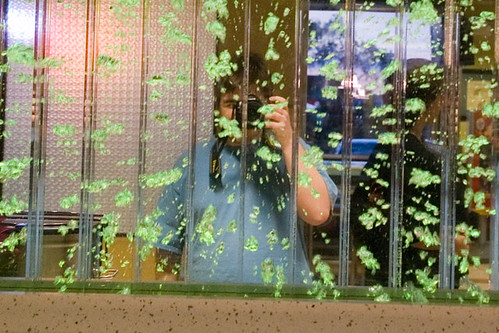Well, I've gone and done it, I suppose. I've impulse-bought a new camera. It's not a half-bad camera either, I got the Nikon D300, and an "AF-S Nikkor 18-135mm 3.6-5.6G ED DX" lens for it, along with a filter for the lens, and a fast 2 gig CF card. I bought it at Ritz Camera after Megan and I had dinner at Ruby Tuesday's. The images in this post should link up to full-resolution versions of the images that came out of the camera. I did minimal work on them using the included Nikon Capture NX software. Unfortunately though, my ThinkPad's display is not calibrated.
I decided to buy it at Ritz because the D300 is new enough that it costs just about the same amount of money everywhere, and because it was a situation where I could have it and start using it right away. And right away did I start. The very next morning after my shower, I unpacked the D300 and its lens. What an exciting feeling, that of unpacking a new piece of equipment and starting to use it. I carefully removed the D300 and the lens from their boxes, taking care to take a variety of hopefully-interesting photos with the D50.
So far, the difference is rather amazing, especially in the lens. The lens isn't that different from my old Quantaray 18-125mm lens, except for the fact that this one seems much sharper so far. I haven't used under all of the same types of conditions as the Quantaray, but I'm sure it'll be less than a year before I can tell whether or not I really think this lens is a better lens. I can tell you now though, I think this is a better lens.
The body is extremely well-built, its heftiness, speed and overall build quality show that it's a higher end camera than the D50, which in and of itself is an excellent piece of imaging technology, from a usability as well as a quality standpoint. The difference in the amount of pixels is readily apparent, especially on my mobile computer, which has been suffering performance problems as of late anyway. The other most apparent differences are in the speed of shooting, which is immense. I have always thought of my D50 as fast, but this thing can rapidly fire off nine or ten shots without even blinking. Said images will be properly focused too, because the AF system on this body is amazing. The other immediately noticeable difference is the review screen. The review screen on this camera is nothing short of amazing. It's significantly larger than that of the D50, which back in 2005 and 2006, I remember saying was very large and bright.
I took it out for a test drive after unpacking everything and getting used to controlling it. (Not to say that I'm very good at it yet, but I'm getting used to it.) My initial reaction to shooting with it is that I feel like I'm getting the shot I want, when I'm framing and shooting, even if I'm shooting something I didn't expect to be, or if I'm walking around and I happen to see some people I recognize, such as the image above of Tracy. The only bad thing I've got to say about the body is that when I was setting it up and hooking up the camera strap, I did so in a retarded way, and while walking around,
I took it to the overnight too, and although it's not necessarily as great a low-light performer as the D300, I'm sure that between the onboard flash and the Nikon SB600 I've got hanging around, I'll manage. I used the SB600 on the image of the D50 at the top of this post. Although even at relatively high ISOs, the D300 does still procure nice images. The image of the Dell OptiPlex in the SLAC was shot at ISO1000. (The D300 supports all of these weird ISO numbers I've only ever seen on Olympus cameras before.)
One of the things I think some people may now be thinking is "what about that non-full-frame sensor?" Unfortunately, that was one of my biggest desires for the camera upgrade, and it's the one thing I didn't get. I'm not too terribly sad at this point though. For one thing, getting a full-frame sensor requires either saving a few additional years to be able to afford the Nikon D3, or a switch to Canon.
I was seriously considering that switch to Canon too. However, the thing about that is that I've already got four different Nikon lenses, the Nikon flash, the off-camera Nikon flash sync cord, and in general, I'm pretty decent at using my Nikon stuff. The other thing is that the currently-available Canon full-frames are the 1Ds-Mark II, the 1Ds-Mark III and the 5D. None of which can be had new for less than $2000. BH has the 5D for $2100, compared to the D300's $1800, and the lens I wanted for the Canon was just shy of $1300. That's a pain in the wallet. And really, being that the 5D was released in 2005, it's out of date and due for a replacement. A replacement that will most likely cost significantly more than the 5D's current price anyway. Aside from the sensor thing, for the savings, the D300 is a significantly better camera in nearly every way.
Although, they say that what makes a great camera isn't necessarily the megapixels or the image processor or the brand or the size of the sensor. It's the ability that the camera has to let the photographer create an image. And while I think that one of my talents as a photographer is to be able to get the results I want out of nearly any piece of equipment. The D300 just happens to let me be even more sure of the images I'm making, and it lets me make them a little bit faster.



